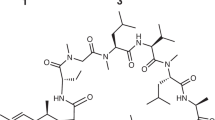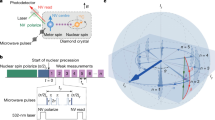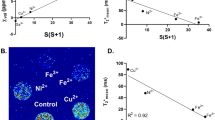Abstract
Population inversion of a selected region of a spectrum is a concept which has wide application in both NMR spectroscopy and imaging. While inversion of population at any one frequency is a trivial matter, ensuring an accurate inversion over a specified bandwidth, with negligible perturbation of the magnetization outside that bandwidth, is a major problem. However, by using as a driving function a complex radiofrequency (r.f.) pulse with an envelope of the form (sech βt)1+5i where 1/β is the temporal width and t is time, we have found that above a critical r.f. power threshold, magnetization is accurately inverted over a very sharply defined bandwidth, while outside that region, magnetization is returned to its initial position, and population is unaffected. Within the broad limits imposed by our equipment, we have also discovered that the phenomenon is independent of the incident r.f. power.
This is a preview of subscription content, access via your institution
Access options
Subscribe to this journal
Receive 51 print issues and online access
$199.00 per year
only $3.90 per issue
Buy this article
- Purchase on Springer Link
- Instant access to full article PDF
Prices may be subject to local taxes which are calculated during checkout
Similar content being viewed by others
References
McCall, S. L. & Hahn, E. L. Phys. Rev. 183, 457–485 (1969).
Lamb, G. L. Phys. Rev. A9, 422–430 (1974).
Author information
Authors and Affiliations
Rights and permissions
About this article
Cite this article
Silver, M., Joseph, R., Chen, CN. et al. Selective population inversion in NMR. Nature 310, 681–683 (1984). https://doi.org/10.1038/310681a0
Received:
Accepted:
Issue Date:
DOI: https://doi.org/10.1038/310681a0
This article is cited by
-
Nonlinear Chirp Sequence for Broadband \(\pi \) Rotation Using Hyperbolic Secant Pulse
Applied Magnetic Resonance (2024)
-
Hybrid-state free precession in nuclear magnetic resonance
Communications Physics (2019)
-
Exact broadband excitation of two-level systems by mapping spins to springs
Nature Communications (2017)
-
Linking the rotation of a rigid body to the Schrödinger equation: The quantum tennis racket effect and beyond
Scientific Reports (2017)
-
Pulsed arterial spin labelling at ultra-high field with a B 1 + -optimised adiabatic labelling pulse
Magnetic Resonance Materials in Physics, Biology and Medicine (2016)
Comments
By submitting a comment you agree to abide by our Terms and Community Guidelines. If you find something abusive or that does not comply with our terms or guidelines please flag it as inappropriate.



